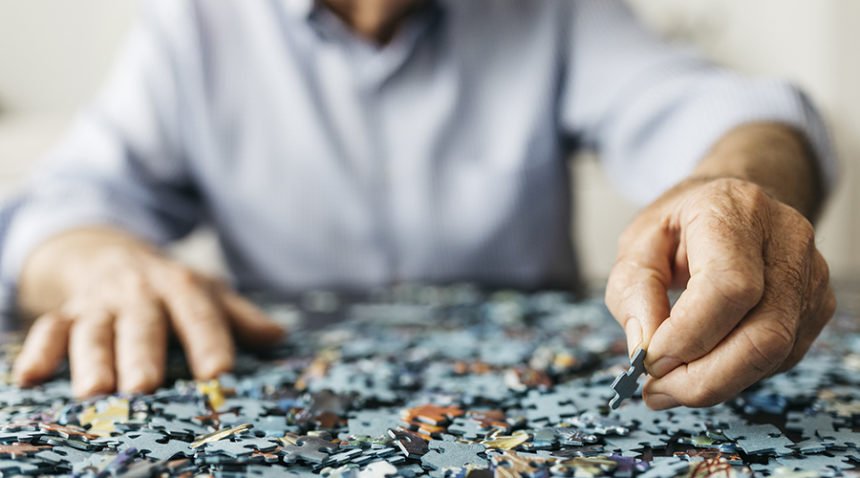If you suffer from pain caused by arthritis, you’re not alone. A leading cause of disability, arthritis affects nearly 1 in 4 adults in the United States. When you’re in pain, doing even simple tasks can feel impossible.
UNC Department of Allied Health Sciences occupational therapist Jenny Womack, PhD, OTR/L, shares these five “hacks” to help ease joint pain while also protecting your joints.
1. Use tools with larger handles.
If you have pain in your hands, it can be difficult to grasp things such as scissor handles or a vegetable peeler.
“One common hack is to enlarge handles on the tools that you use,” Dr. Womack says. For example, “You can take a washcloth and wrap it around the handle of what you’re using.”
This helps you widen your grasp so it’s not as painful.
Another option is to use hollow foam insulation you can buy at a hardware store; cut it on one side and slip it over handles to make them bigger. Some household tools are available with enlarged handles, such as a vegetable peeler from Oxo Good Grips.
2. Change your position—and use tools and technology when possible.
“We focus a lot on hands because they’re how you do most of your daily tasks,” Dr. Womack says. “So look at ways you can change the position of your hand.”
For example, when you’re peeling vegetables, you may hold the peeler in a way that stresses your hand and wrist joints because you’re gripping and moving the wrist in a repetitive motion. You can find tools that solve this problem; for example, a company called Chef’n makes a peeler that allows you to keep your hand flat.
If you have pain in your thumb joints, grasping the top of a jar lid to open it can be painful. Dr. Womack recommends turning your hand “completely upside down, to where your thumb is toward the floor and your forearm is rotated. Although this is a really strange upward position, it allows you to open the jar by extending your wrist instead of moving toward your thumb,” Dr. Womack says.
An even easier solution is to install a mounted jar opener. People with arthritis also can benefit from electric can openers, number pad locks instead of keys and voice texting rather than typing, Dr. Womack says.
Position changes aren’t just for the hands, either; for example, if you enjoy sewing but are using a foot pedal and you have arthritis in your foot and ankle, mount your sewing machine pedal in a place where you can contact it with your knee instead of your foot.
An occupational therapist can help identify strategies like this and tailor them to your daily life and tasks.
3. Use larger joints instead of your hands.
If you have arthritis, carrying plastic bags full of groceries in your hand for a few minutes can be excruciating. It’s an incredibly stressful position for your knuckles.
Whenever you have to sustain a hand grip, think about shifting to larger joints, like your shoulders and elbows, Dr. Womack says. For example, carry a grocery bag with your hands underneath it, cradling it close to your body instead of carrying it by the handles. Or instead of carrying a purse or briefcase by the handles, use a shoulder strap.
“You’re moving that weight and that force to the larger joints in your body instead of the smaller hand joints,” Dr. Womack says.
4. Elevate your surfaces.
People with arthritis often have a hard time getting up from sitting without pain in joints such as their knees, hips or ankles. And it can be a vicious cycle, Dr. Womack says: When you shift the weight from your arms to relieve your knees, you put it into your wrists and hands.
Look at the seating surfaces in your home where you spend the most time and think about elevating them with risers or firm cushions. Then your joints will have to do less work when you want to get up and down.
“It’s a biomechanical issue. You’re going to have a better lever if you raise your seats, your bed and other things so you do not have to move quite so far through space,” Dr. Womack says.
5. Pace yourself.
While joint protection is very important for people with arthritis, so is energy conservation, especially if you have an immune system-related arthritis such as rheumatoid arthritis.
“The fatigue that can come along with that can be pretty disabling, so we try to help people think across their entire day, and really think about the tasks that require both joint involvement and a lot of physical endurance,” Dr. Womack says.
You’ll want to take on more physically taxing tasks when you feel rested and when your joints are warmed up but not fatigued. And spread out the work.
“You don’t want a three-hour period of doing everything that’s the heaviest load or the heaviest lifting, such as three loads of laundry and vacuuming the floor,” Dr. Womack says. “Distribute the tasks throughout the day.”
Do your joints hurt? Talk to your doctor or find one near you.

